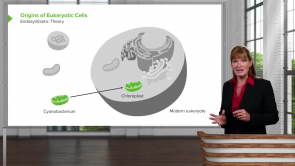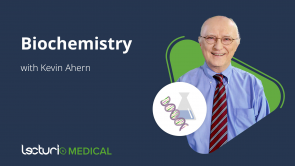Genetic Code

Über den Vortrag
Der Vortrag „Genetic Code“ von Kevin Ahern, PhD ist Bestandteil des Kurses „RNA and the Genetic Code“.
Quiz zum Vortrag
Which of the following is true regarding aminoacyl tRNA synthetase?
- It reads the anticodon in the tRNA to put the right amino acid on the tRNA.
- It is responsible for transcribing tRNAs.
- It attaches random amino acids to the end of a tRNA.
- It is found in 64 different forms — one for each codon.
- It reads the codon in the tRNA.
Which of the following is not correct regarding the genetic codon?
- The viral genetic codon is composed of a set of twenty-seven codons which direct the synthesis of viral proteins in the host cells.
- The genetic codon is composed of a set of three bases or nucleotides which code for one amino acid.
- The genetic codon is universal, comma-less, co-linear, unambiguous, and non-overlapping.
- The gene-polypeptide parity says that a specific gene gets transcribed to a specific mRNA which directs the synthesis of a specific polypeptide chain.
- The genetic codon establishes the relationship between the sequence of bases in nucleic acids and the sequence of amino acids in proteins.
Which of the following is not matched correctly regarding the genetic codon?
- Redundant genetic codon — signal for the end of translation process during protein synthesis
- Sense codons — code for the amino acids
- AUG codon — codes for methionine as well as serves as an initiation site during the translation process
- Signal codons — these code for the start and stop of the translation process
- Stop codons — in mRNA, amber (UAG), ochre (UAA) and UGA (opal) codons act as the translation termination signal
How does the aminoacyl-tRNA synthetase enzyme help to improve the accuracy of the translation process?
- The aminoacyl-tRNA synthetase ensures the attachment of the correct amino acid to the corresponding tRNA molecule.
- The aminoacyl-tRNA synthetase ensures the attachment of release factors at the stop codon during the translation process.
- The aminoacyl-tRNA synthetase ensures the release of amino acid from the corresponding tRNA and helps in its attachment to the growing polypeptide chain.
- The aminoacyl-tRNA synthetase ensures the continuous movement of ribosomes on the mRNA during the translation process.
- The aminoacyl-tRNA synthetase helps in the formation of the ribosome by facilitating the joining of smaller and larger subunits of the ribosome.
Where do type-1 and type-2 aminoacyl-tRNA synthetase enzymes attach amino acids?
- Amino acids are attached to the 2’OH and 3’OH of terminal A of the tRNA, respectively.
- Amino acids are attached to the 1’OH and 3’OH of terminal A of the tRNA, respectively.
- Amino acids are attached to the 3’OH and 2’OH of terminal A of the tRNA, respectively.
- Amino acids are attached to the 2’OH and 1’OH of terminal A of the tRNA, respectively.
- Amino acids are attached to the 1’OH and 2’OH of terminal A of the tRNA, respectively.
Diese Kurse könnten Sie interessieren
Kundenrezensionen
5,0 von 5 Sternen
| 5 Sterne |
|
5 |
| 4 Sterne |
|
0 |
| 3 Sterne |
|
0 |
| 2 Sterne |
|
0 |
| 1 Stern |
|
0 |






